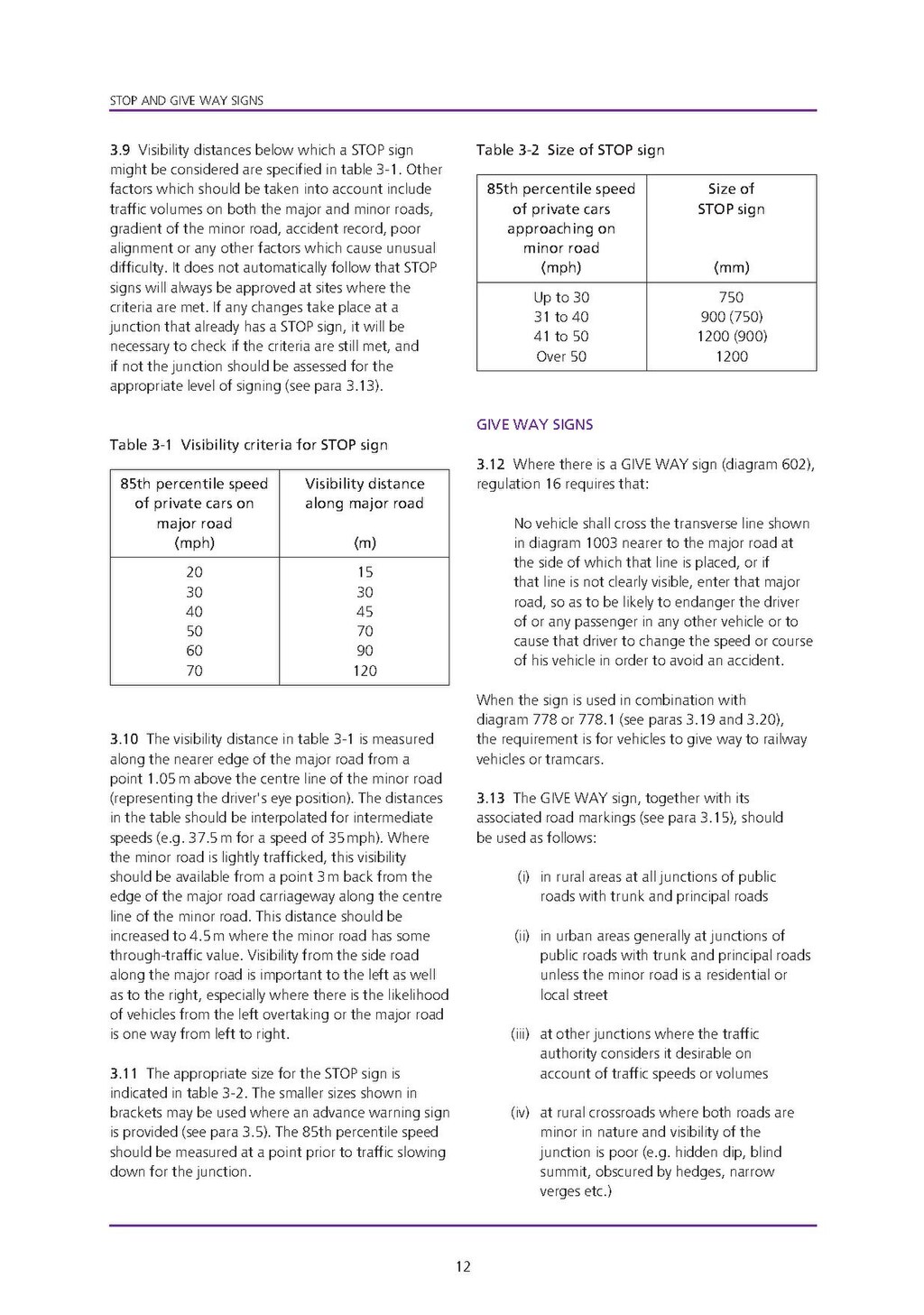3.9 Visibility distances below which a STOP sign might be considered are specified in table 3-1. Other factors which should be taken into account include traffic volumes on both the major and minor roads, gradient of the minor road, accident record, poor alignment or any other factors which cause unusual difficulty. It does not automatically follow that STOP signs will always be approved at sites where the criteria are met. If any changes take place at a junction that already has a STOP sign, it will be necessary to check if the criteria are still met, and if not the junction should be assessed for the appropriate level of signing (see para 3.13).
| 85th percentile speed of private cars on major road |
Visibility distance along major road |
|---|---|
| (mph) | (m) |
| 20 | 15 |
| 30 | 30 |
| 40 | 45 |
| 50 | 70 |
| 60 | 90 |
| 70 | 120 |
3.10 The visibility distance in table 3-1 is measured along the nearer edge of the major road from a point 1.05 m above the centre line of the minor road (representing the driver's eye position). The distances in the table should be interpolated for intermediate speeds (e.g. 37.5 m for a speed of 35 mph). Where the minor road is lightly trafficked, this visibility should be available from a point 3 m back from the edge of the major road carriageway along the centre line of the minor road. This distance should be increased to 4.5 m where the minor road has some through-traffic value. Visibility from the side road along the major road is important to the left as well as to the right, especially where there is the likelihood of vehicles from the left overtaking or the major road is one way from left to right.
3.11 The appropriate size for the STOP sign is indicated in table 3-2. The smaller sizes shown in brackets may be used where an advance warning sign is provided (see para 3.5). The 85th percentile speed should be measured at a point prior to traffic slowing down for the junction.
| 85th percentile speed of private cars approaching on minor road |
Size of STOP sign |
|---|---|
| (mph) | (mm) |
| Up to 30 | 750 |
| 31 to 40 | 900 (750) |
| 41 to 50 | 1200 (900) |
| Over 50 | 1200 |
GIVE WAY SIGNS
3.12 Where there is a GIVE WAY sign (diagram 602), regulation 16 requires that:
No vehicle shall cross the transverse line shown in diagram 1003 nearer to the major road at the side of which that line is placed, or if that line is not clearly visible, enter that major road, so as to be likely to endanger the driver of or any passenger in any other vehicle or to cause that driver to change the speed or course of his vehicle in order to avoid an accident.
When the sign is used in combination with diagram 778 or 778.1 (see paras 3.19 and 3.20), the requirement is for vehicles to give way to railway vehicles or tramcars.
3.13 The GIVE WAY sign, together with its associated road markings (see para 3.15), should be used as follows:
(i) in rural areas at all junctions of public roads with trunk and principal roads
(ii) in urban areas generally at junctions of public roads with trunk and principal roads unless the minor road is a residential or local street
(iii) at other junctions where the traffic authority considers it desirable on account of traffic speeds or volumes
(iv) at rural crossroads where both roads are minor in nature and visibility of the junction is poor (e.g. hidden dip, blind summit, obscured by hedges, narrow verges etc.)
12
